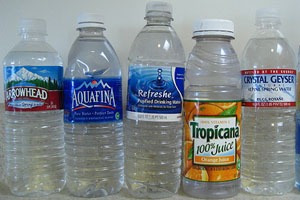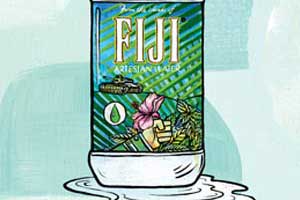
Photo used under a Creative Commons license by flickr user <a href="http://www.flickr.com/photos/dannyman/">dannyman</a>
In the course of fact-checking Anna Lenzer’s excellent piece on Fiji Water, and in writing my own sidebars to the piece, I drank a lot of water. And truthfully, I liked the taste of the stuff coming out my San Francisco tap better than the Dasani or Arrowhead I bought from the bodega. So I got to wondering: Can all these bottled waters on the shelf really taste that differently from one another? Are they better than tap? Could I even tell the difference between Volvic and Voss? To find out, I bought eight bottles of water at my local Whole Foods and had a blind taste test in the Mother Jones office with several editors, interns, fellows, and art staff. For a good measure, we also included filtered and unfiltered San Francisco tap in the test.
The results: Fiji Water, for all its claims of purity, tasted okay to our staff. One or two people out of about ten said it was their favorite. “I actually liked Fiji best,” said one staffer, who will remain anonymous.
The favorite waters, by a pretty good margin, were Volvic and Whole Foods’ 365 electrolyte-enhanced water. San Francisco tap (unfiltered) also did well, and Voss was lauded for being the most “neutral” water (it literally tasted like air). I had high hopes for Eternal water from New Zealand, which had the prettiest packaging, but our reviewers found it positively intolerable with comments like “gross,” “plastic flavor,” and “tasted like it sat out for a while.” Similarly, Balance water, which boasts Australian wildflower essences, was rated “not so great” and “diz-gusting.”
For whatever reason, reviewers liked the taste of San Francisco tap far better than filtered tap, saying the filtered tasted tinny and metallic while the unfiltered was cleaner and lighter, even “slightly fruity.” Maybe that’s because our staff is used to drinking unfiltered tap (Kleen Kanteens are legion in the MoJo HQ), or maybe it’s because San Francisco tap is purer than most bottled waters: It comes from the granite-lined Hetch Hetchy Reservoir in Yosemite National Park, 167 miles from San Francisco. It’s good quality water, so pure that the San Francisco Public Utilities Commission is not even required to filter it because it already meets or exceeds all federal and state standards naturally.
Most bottled waters—whose sources could be municipal tap, aquifier, or spring waters—are treated to a number of processes, such as being flashed with ultraviolet light to get rid of bacteria and other unwanted organisms. In fact, bottled water manufacturers often distill their water so heavily that they actually reintroduce minerals later for taste. Despite the often elaborate processes bottled water companies take to purify their water, a GAO report last month found that the FDA puts less stringent requirements on bottled water than the EPA does on tap water. Another tap water bonus: It costs only about $.003 per gallon (versus about $6 per gallon for bottled water), and has a low carbon footprint.
Below is the listing of the waters we tasted, in rough order of preference. What’s your favorite bottled water? Do you drink based on taste, or CO2 footprint? And can you taste the difference?
1. Volvic
2. Whole Foods 365 electrolyte-enhanced
3. San Francisco tap, unfiltered
4. Voss
5. Fiji
6. Evian
7. Dasani
8. San Francisco tap, filtered
9. Balance
10. Eternal












